During WWII, the Allies had endured mother nature in many forms such as hot arid deserts, fog, rain, hurricanes, floods, deep mud, cold temperatures, ice, sleet and deep snow. In March 1944 Italy, the bombers of an USAAF Medium Bomber Group were either damaged or destroyed on the ground, not by the enemy but by a volcano. Mount Vesuvius erupted showering volcanic ash and debris over the US bomber airfield.

Mount Vesuvius is a somma-stratovolcano (composite or conical volcano) located on the Gulf of Naples in Campania, Italy, about 9 km (5.6 miles) southeast of Naples and a short distance from the shore. It was named after the Roman God of the Flame and Metal Forgery – Vulcan.
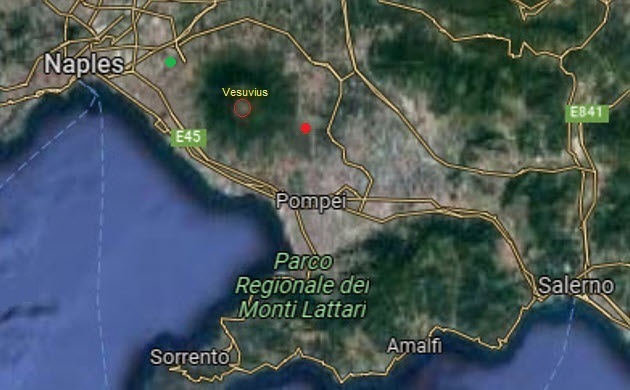
Mount Vesuvius has erupted many times since prehistory. In AD 79, Vesuvius erupted in one of the most catastrophic eruptions of all time. Historians have learned about the eruption from the eyewitness account in two letters of Pliny the Younger, a Roman administrator and poet. Pliny the Younger described the last days in the life of his uncle, Pliny the Elder, observing the first volcanic activity from Misenum across the Bay of Naples. The cities of Pompeii, Herculaneum, and other Roman settlements were destroyed. Pompeii was covered with molten lava, ash, pumice volcanic blocks, and toxic gases. The entire eruption lasted 12 to 18 hours. Afterwards, everything was perfectly preserved and fossilized by the deep volcanic ash. Since the eruption of AD 79, Vesuvius has erupted around 30 times. It erupted in 203, during the lifetime of the historian Lucius Cassius Dio (155 – 235). In 472, it ejected such a volume of ash that ash falls were reported as far away as Constantinople (760 miles; 1220 km). The eruptions of 512 were so severe that those inhabiting the slopes of Vesuvius were granted exemption from taxes by Theodoric the Great, the Gothic king of Italy. Further eruptions were recorded in 787, 968, 991, 999, 1007 and 1036 with the first recorded lava flows. The volcano became inactive at the end of the 13th century, and in the following years it again became covered with gardens and vineyards. Even the inside of the crater was moderately filled with shrubbery. Vesuvius entered a new phase in December 1631, when a major eruption buried many villages under its lava flows, killing around 3000 people. Torrents of lahar (mud flows) were also created, adding to the devastation. Activity there after became almost continuous, with relatively severe eruptions occurring in 1660, 1682, 1694, 1698, 1707, 1737, 1760, 1767, 1779, 1794, 1822, 1834, 1839, 1850, 1855, 1861, 1868 and 1872.
The eruption of 7 April 1906 killed more than 100 people and ejected the most lava ever recorded from a Vesuvian eruption. The Italian authorities were preparing to host the 1908 Summer Olympics in Rome when Vesuvius violently erupted, devastating the city of Naples and the surrounding areas. The funds for the Olympics were diverted to the reconstruction of Naples and the 1908 Olympics were instead held in London, England.
Vesuvius was active from 1913 through 1943, with lava filling the crater and occasional outflows of small amounts of lava. During the eruption between 3-8 June 1929, a lava flow advanced towards Terzigno, destroyed the village of Boscotrecase and heavy damage in Ottaviano.
When a volcano explodes, besides lava it releases a variety of tephra including ash, cinders, and blocks. Volcanic tephra consists of fragments of rock, mineral crystals, and volcanic glass.
Tephra fragments are classified by size:
- Ash – particles less than 2 mm (0.08 inches) in diameter.
- Cinders – between 2 and 64 mm (0.08 and 2.5 inches) in diameter.
- Volcanic blocks or bombs – greater than 64 mm (2.5 inches) in diameter.
The larger and/or heavier the tephra is, it usually fell closer to the volcano.
Local air currents affected the distance and direction that the volcanic ash clouds traveled.
WWII
The 340th Bombardment Group was activated on 20 August 1942 and trained with B-25 Mitchell bombers for duty overseas. The group arrived in the Mediterranean theater of Operation in March 1943. It was first assigned to the US Ninth Air Force and in August 1943 assigned to the US Twelfth Air Force. The group supported British Eighth Army in Tunisia during the assault on the Mareth Line and supported Allied forces in Sicily and the landings at Salerno, Italy. The group became known as “The Avengers”.
Bases:
- El Kabrit, Egypt, March 1943
- Medenine, Tunisia, March 1943
- Sfax, Tunisia, April 1943
- Hergla, Tunisia, 2 June 1943
- Comiso, Sicily, 2 August 1943
- Catania, Sicily, 27 August 1943
- San Pancrazio, Italy, 15 October 1943
- Foggia, Italy, 19 November 1943
Distinguished Unit Citations:
- North Africa, 17 April 1943
- Sicily, August 1943
340th Bombardment Group:
- 486th Bomb Squadron
- 487th Bomb Squadron
- 488th Bomb Squadron
- 489th Bomb Squadron

The tail Codes carried on the 340th Bombardment Group B-25s consisted of the last digit of squadron number (6 – 9) and the plane letter (A – Z).
Pompeii Airfield
Pompeii Airfield was located approximately 1 km (0.62 mile) south of Terzigno, a few kilometers east of the base of Mount Vesuvius, and approximately 20 km (12.4 miles) east-southeast of Naples.

The airfield was an all-weather temporary field built at the end of 1943 by the XII Engineering Command of the USAAF 12th Air Force on a graded earth compacted surface with Prefabricated Hessian (burlap) Surfacing known as PHS. PHS was made of an asphalt-impregnated jute which was rolled out over the compacted surface over a square mesh track (SMT) grid of wire joined in three-inch (76.2 mm) squares. Pierced Steel Planking (PSP) was also used for parking areas and dispersal sites when it was available. Dumps for supplies, bombs, ammunition, gasoline drums, drinking water, and an electrical grid for communications and lighting were also constructed. Tents were used for billeting air crews, ground personnel and support facilities, and an access road was built to connect the airfield facilities with existing roads in the area.
Other Airfields
Gaudo Airfield was located approximately 3 km (1.86 miles) north of Paestum and about 70 km (43.5 miles) southeast of Naples, south of Salerno. The airfield was used by the 321st Bombardment Group (Medium) flying B-25 Mitchell bombers.
Capodichino Airfield was located north of Naples and was built during WWI to defend Naples against Austro-Hungarian and German air attacks. The airfield was used by the US 79th Fighter Group “FALCONS” consisting of the 85th “Flying Skulls”, 86th “Commanches” and 87th “Skeeters” Fighter Squadrons (FS). In early 1944, the 79th was transitioning from the Curtiss P-40 Warhawk to the Republic P-47 Thunderbolt. The 99th Fighter Squadron (African American Tuskegee) flying P-40s was also attached to the 79th Fighter Group.
Cercola Airfield was located east of Naples and northwest of Vesuvius. The airfield was used by the US 9th Air Force 324th Fighter Group (314th FS, 315th FS, 316th FS) and the 57th Fighter Group (64th FS “Black Scorpions”, 65th FS “Fighting Cocks”, 66th FS “Exterminators”) all flying P-40 Warhawks. Both Gaudo and Cercola were all-weather temporary airfields constructed in the same matter as Pompeii Airfield.
Foggia Airfield was located approximately 3 km (1.86 miles) southwest of Foggia, northeast of Naples on the east coast of Italy. It was a captured Regia Aeronautica airfield used by US 12th and 15th Air Forces as both an operational airfield and as major command and control headquarters.
On 2 January 1944, the 340th Bombardment Group relocated from Foggia Airfield to Pompeii Airfield. The 340th participated in Operation Strangle where it engaged mainly in support and interdiction missions, but sometimes it bombed strategic objectives. Targets included airfields, railroads, bridges, road junctions, supply depots, gun emplacements, troop concentrations, marshalling yards and factories.
This is an aerial view of Pompeii Airfield sometime before March 1944. The parking areas were spread out to minimize damage in case of an enemy air attack.

On 22 January 1944, the Allies launched Operation Shingle, the amphibious landing of the US VI Corps at Anzio with the objective of outflanking German forces along the Gustav Line around Cassino (northwest of Naples) and to liberate Rome.
340th early 1944 bombing missions:
| Mission Date | Target | Squadrons |
| 15 January 1944 | Foligno | 487, 488, 489 |
| 16 January 1944 | Terni Marshalling Yard | 486, 488 |
| 17 January 1944 | Chiaravalle | 487, 488, 489 |
| 19 January 1944 | Rieti Airdrome | 486, 487, 488, 489 |
| 23 January 1944 | Avezzano Road and Railroad Junction | 486, 487, 488, 489 |
| 27 January 1944 | Orte Marshalling Yard | 486, 487, 488, 489 |
| 7 February 1944 | Viterbo Marshalling Yard | 486, 487, 488, 489 |
| 7 February 1944 | Cisterna | 487, 489 |
| 12 February 1944 | Campolone Area | 487, 489 |
| 14 February 1944 | Perugia Marshalling Yard | 487, 488, 489 |
| 7 March 1944 | Littorio Marshalling Yard | 486, 487, 489 |
| 10 March 1944 | Littorio Marshalling Yard | 486, 487, 489 |
| 13 March 1944 | Perugia Marshalling Yard | 486, 487, 488, 489 |
| 14 March 1944 | Terni Marshalling Yard | 486, 487, 488, 489 |
| 15 March 1944 | Cassino Northwest | 486, 487, 488, 489 |
| 15 March 1944 | Cassino | 486, 487, 488, 489 |
| 18 March 1944 | Foligno Marshalling Yard | 486, 487, 488, 489 |
Note: The whole squadron did not fly each mission.
Vesuvius Erupts
In March 1944, Mount Vesuvius eruption cycle began:
March 1: tremor activity decreased; sporadic earthquakes occurred; level in lava lake lowered; production of lava decreased.
March 11: several explosions; central crater partially collapses.
March 17: activity ceased completely.
March 18: 1400 hours: seismic activity rises sharply. 1600 hours: crater opens; heavy explosions; lava lake active for 3 days producing several lava flows down the slopes.
March 19: lava flows destroyed the villages of San Sebastiano al Vesuvio, Massa di Somma, Ottaviano, and part of San Giorgio a Cremano.
March 20: lava fountains 2 km (1.2 miles) high.
March 21: effusive activity ceases, then explosive activity producing small pyroclastic flows.
March 22: collapse of conduit; explosions.
March 23: Ash falls to the east.
March 26: White ash falls indicating the final phase of the eruption.
US troops watch in awe at Mount Vesuvius bellowing massive amount of smoke in the background.

A flight (5 or 6) of B-25s of the 447th Bomb Squadron, 321st Bombardment Group flew pass the erupting Vesuvius while enroute to a bomb target. This photo had to been taken before March 21 because the 321st flew no bombing missions between March 21 to 26 due to bad weather. Not able to find any information if any of the B-25s were hit by any volcanic “flak”. Note that 11 B-25s of the 321st group participated in the Allied bombing of the Cassino Abbey on February 15.

As Vesuvius erupts, a P-40 Warhawk from Capodichino Airfield fly pass in the foreground.

Cercola Airfield had a great view of Vesuvius erupting and luckily it did not receive any significant damage. In the foreground is a P-40 Warhawk of either the 324th or 57th Fighter Group. The plane is mostly covered and not able to determine which squadron it belonged to.
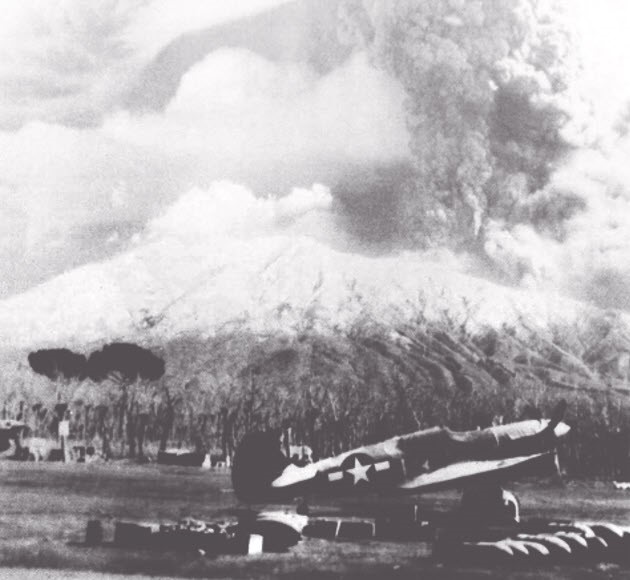
A R4 gasoline powered Caterpillar bulldozer plowing through volcanic ash leads a column of trucks.
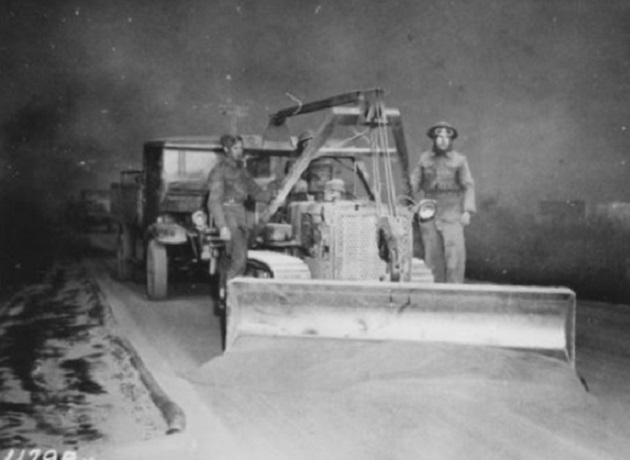
Film: Eruption of Mt Vesuvius 1944
Film: Vesuvius Eruption (1944)
Film: MOUNT VESUVIUS ERUPTING NAPLES, ITALY
No lives were lost, the only casualties were a sprained wrist and a few cuts, except for the effects of the volcano on the bombers on the airfield. The estimates varied, there were between 78 and 88 aircraft damaged or destroyed.
Airfield Evacuation
On March 22, the 340th Bombardment Group decided to evacuate the Pompeii Airfield because of the possibility of increased volcanic activity and the threat of dangerous lava flows approaching from the slopes of the mountain. Approximately one foot (30.48 cm) of ash already covered the ground. Men and equipment of the 1st, 324th and 303rd Service Squadrons, 19th Service Group arrived at the airfield to assist the ground personnel in recovering the bombers. The next day, the airfield was dismantled and the 340th Group was relocated south to Gaudo Airfield, Paestum.
The tail of B-25 6C has been jacked up and ground crew are about to the overhaul the aircraft with Vesuvius smoking in the background. Initially, the Americans were not concerned about the smoking volcano close to the airfield and thought they would not need to evacuate.
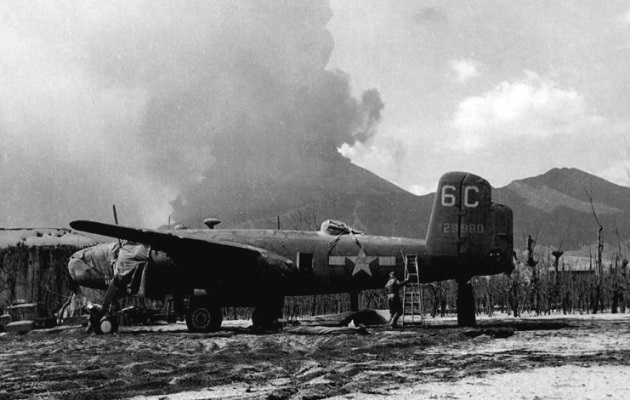
This is my close up of the tail of B-25 6C. Serial number 41-29980 indicates that this plane is a B-25D-5.
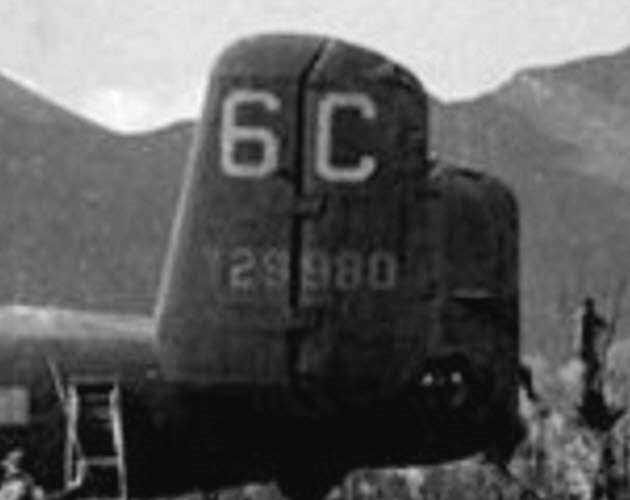
This is B-25 6C after the eruption.
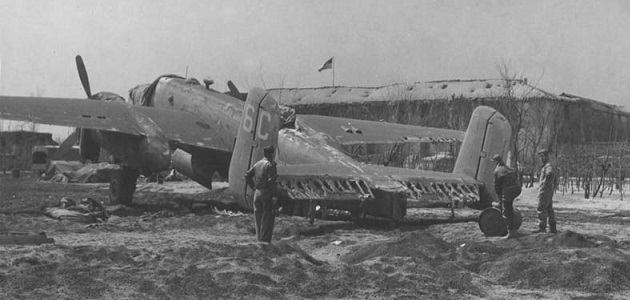
Due to the weight of the volcanic ash, many of the B-25s were tipped back onto their tails. In the foreground is B-25 7U and in the background is B-25 7D.

Film: US bomber planes damaged by Mount Vesuvius eruption at Pompeii
This view is looking at the underside of the starboard (right) wing of B-25 7U with Vesuvius smoking in the background. The fabric covered control surfaces are shredded and the metal flaps are intact. Note the landing light on the wing is damaged.
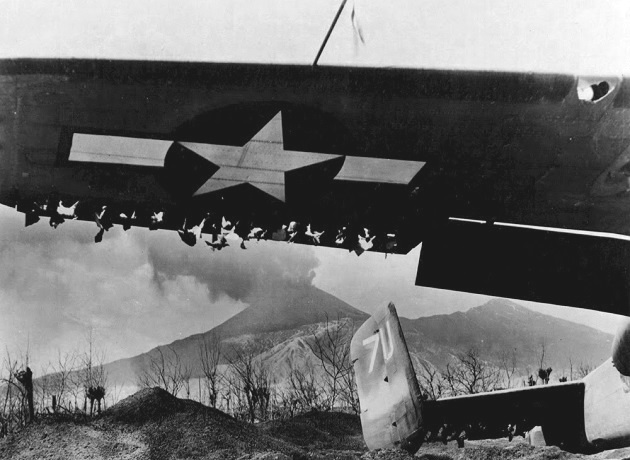
This is a close up of B-25 7D. It looks like a masked gooney bird sitting on its tail.
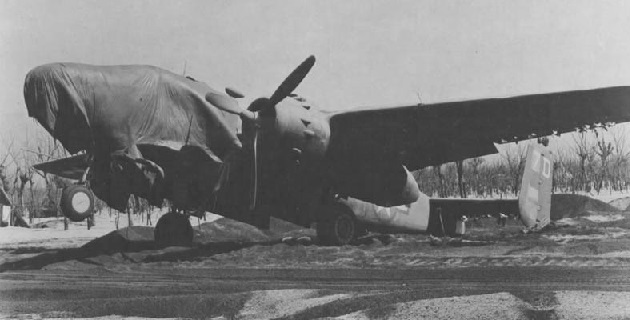
The upper wings and the top of the fuselage of this B-25 is covered with a layer of volcanic ash. All the fabric covered control surfaces on the aircraft were burnt off. This might be the rear of B-25 7D.
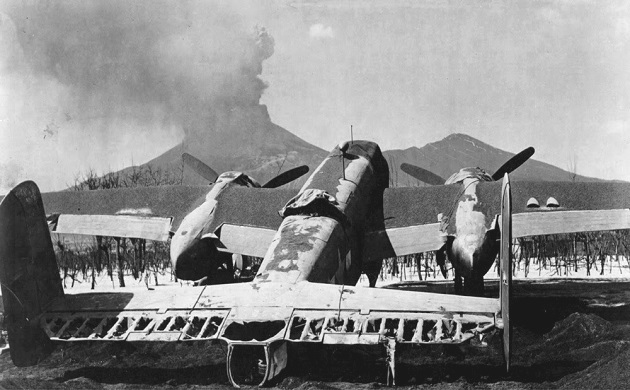
This is another B-25 covered with volcanic ash and has burnt off fabric covered control surfaces. Bombs are still mounted under the wings. The soldier examining the plane is wearing an early WWII US Army M1917A1 “Kelly” helmet. These helmets saw limited use in early WWII, mainly at Pearl Harbor, Wake Island and in the Philippines. Note how deep the ash has piled up around the main landing gear.

A ground crewman is standing on the horizontal stabilizer of a B-25 brushing off volcanic ash. Trucks and Jeeps are in the background.

Another ground crewman is standing on the wind root of a B-25 sweeping off volcanic ash. Two bombs are on the ground beneath the wing probably on bomb carts. Note the damaged astrodome above the navigator’s compartment. The astrodome is a hemispherical transparent dome which allow a trained navigator to perform astronavigation (navigation by the stars).
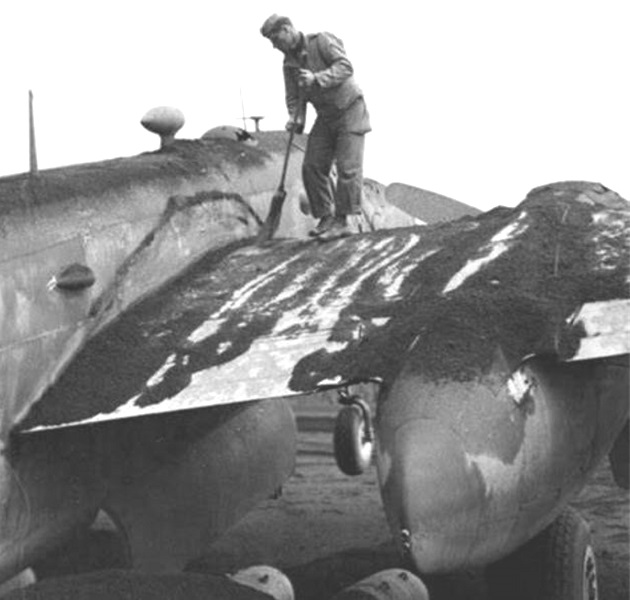
The single “stinger” tail-guns were installed at Kabrit, Egypt. The tail was open to the air and the tail gunner laid on an armor plate to fire the gun. This airman is digging out the tail gun of a B-25 which was buried in volcanic ash. The Browning M2 .50 Cal machine gun appears not to be damaged but it probably had to be completely disassembled and cleaned.

A Caterpillar tractor towing an unpowered grader is clearing a line along the parking areas to enable the B-25s to be towed out. The B-25 in the background might be B-25 7A and the nose of B-25 7D is probably to the right.
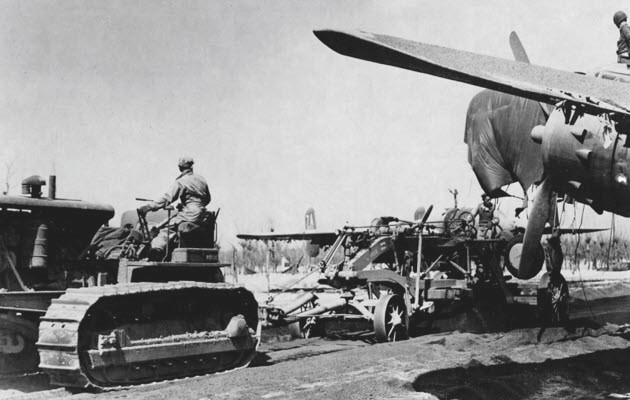
A Caterpillar bulldozer is piling up the volcanic ash.

A couple of ropes have been attached to the nose of this tilted B-25 and four men are pulling on the ropes to bring the nose down. Then it would be hitched to the bulldozer and towed to the salvage area.

A tractor is towing B-25 8U to the salvage area. The serial number on the tail is too faded to read.
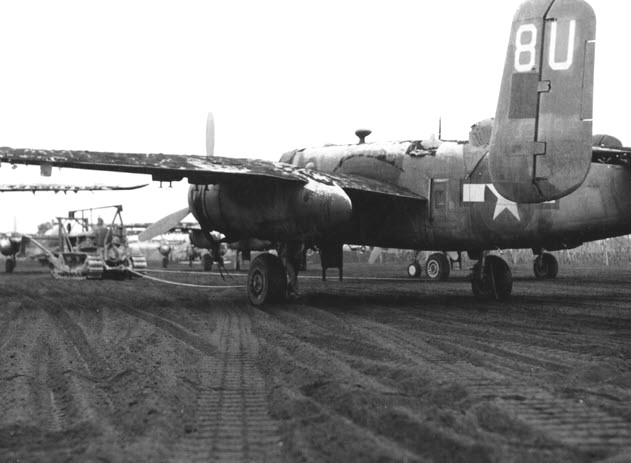
A Caterpillar tractor is hitched to this B-25 to be towed. Tow cables are attached to the bomber’s main landing gear struts.

This is my close up of the above photo. When the tractor started to tow the B-25 with this ground crewman holding the tow bar attached to the nose gear, the nose probably suddenly popped up. The man is putting his weight on the tow bar trying to bring the B-25’s nose down to keep the tail off the ground.
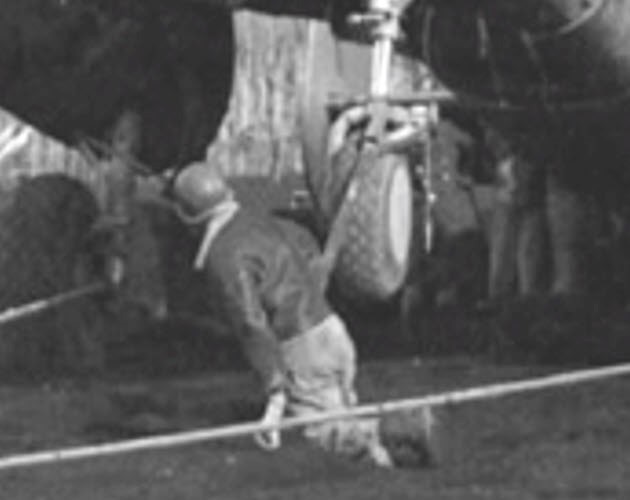
This is a view of the salvage area with repair crews working on the planes.
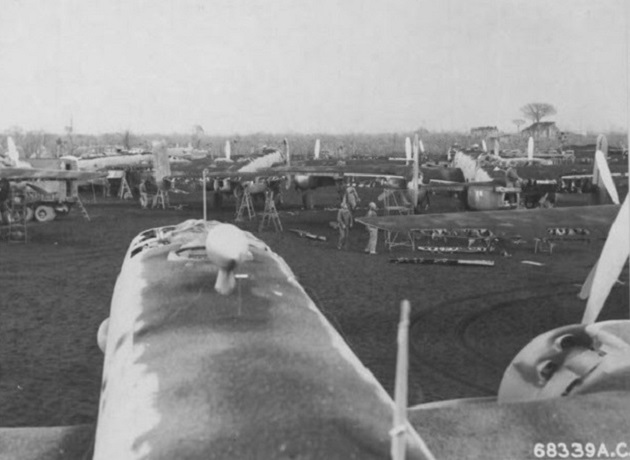
The volcanic ash had glazed, melted, or cracked the exposed Plexiglass windscreens and gun turrets of the B-25s. This top turret dome had been shattered by hot cinders.
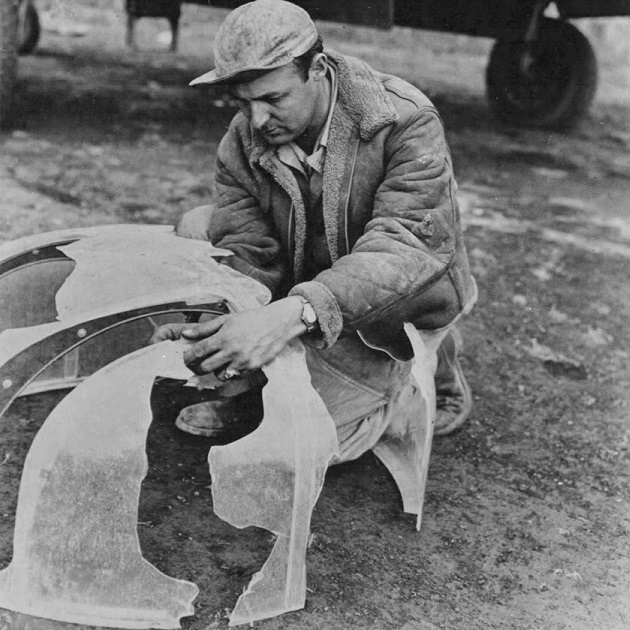
A repair crew is removing a B-25’s nose canopy. There is a crate beneath the nose wheel indicating that the B-25 was still sitting on its tail. Note the bomb mission markings painted below the bombardier’s position.
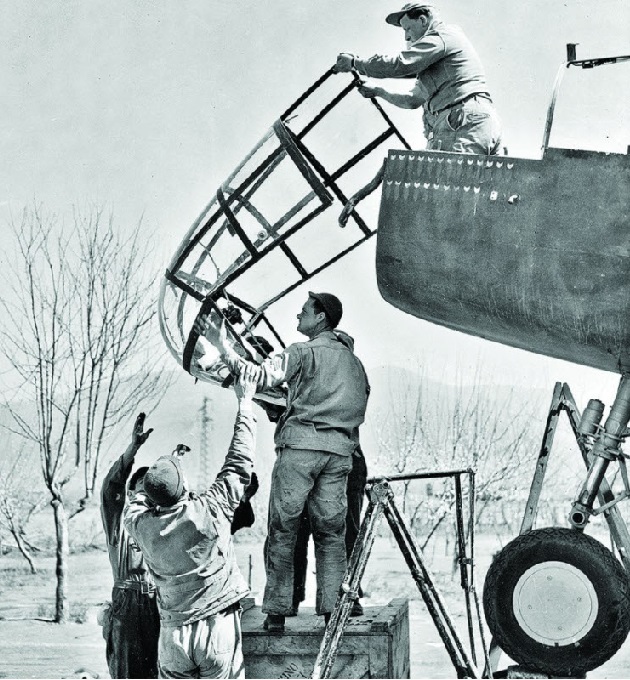
The tail of this battered B-25 has been jacked up with a drum and a couple of crates so that the entrance hatch can be lowered allowing the repair crew access to the inside. During the final eruption phase on March 26, a layer of white colored ash had fallen over the area which looks like snow.
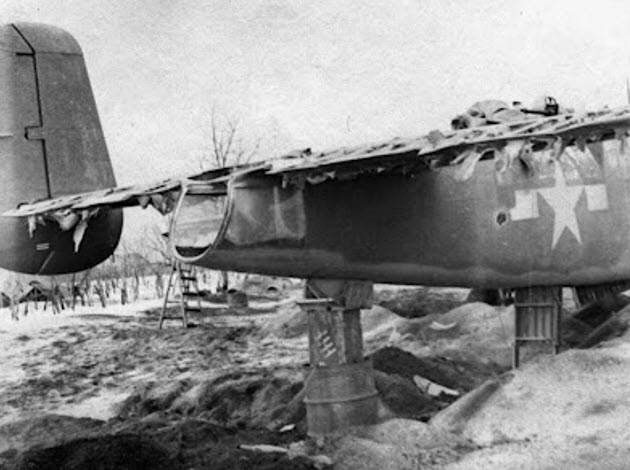
Volcanic ash and cinders had tore holes in the tents on the airfield. A large volcanic bomb or block probably would collapse the whole tent. In the foreground is a Harley Davidson WLA motorcycle surrounded and covered with the volcanic ash.

Over the radio one evening, Axis Sally dedicated her propaganda program to the survivors of the 340th Bomb Group. The following evening she cracked, “We got the Colonel, Vesuvius got the rest” (Group commander Colonel Charles D. Jones was shot down over Littorio on 10 March 1944 and became a POW.) She explained how the 340th was completely devastated and no longer operational which was far from the truth. There were two women referred to as “Axis Sally”, an American-born Italian, Rita Luisa Zucca in Rome and an American, Mildred Elizabeth Gillars in Berlin. It is not known which woman made the broadcasts or if both of them did. After the war, Mildred Gillars became the first woman to be convicted of treason against the United States and she spent 11 years in prison.
Within a week after the eruption, the 340th was again flying bombing missions over enemy targets. The group was temporarily equipped with the cast-offs planes from other B-25 units. Later the group received brand new, natural metal B-25Js identifiable by the top gun turret located behind cockpit instead behind the wing in the center of the rear fuselage. A number of the damaged B-25s were repaired and flown in combat again.
A GMC 2-1/2 ton 6×6 truck tows a recovered B-25 from the Pompeii Airfield to a safe field. Ground crewmen are riding on the wing tips to weigh down the plane and to watch for any obstacles along the sides of the highway (trees, poles, wires, etc.)

B-25 7C named “Rosie” is ready for a flight test after all the repairs were completed. Colonel Limburner, CO of the 19th Service Group, thanks the officers and men for the excellent job they did in making the planes of the 340th Bomb Group ready to fly again.

This is my close up of B-25 “Rosie”. Note all the bomb mission markings under the cockpit.

The Pompeii Airfield was abandoned and nature had reclaimed the land. The volcanic ash provides the soil with essential nutrients and the minerals it contains are beneficial to plants. The fine ash breaks down quickly and mixes with the soil becoming a good fertilizer for crops.
The 340th Bombardment Group received the distinction of losing more aircraft than any other medium bombardment group during WWII. Vesuvius was one of two incidents where the 340th had over and above normal operational losses. The other incident occurred on 12-13 May 1944, during devastating German air raids by Lehrgeschwader 1 on its base at Alesani, Corsica. Approximately 90 planes were on the field, 65 were put out of commission, of which 30 were a total lost, although parts of approximately 24 of them were salvaged. Just as before, the losses were quickly replaced in a similar manner. After the raids, the shiny natural metal B-25Js were quickly painted in Olive Drab camouflage.
Alesani Airfield after the raid on 13 May 1944. In the background, 487th planes 7N and 7P survived. Plane 7P on the right is a B-25J and 7N on the left is a B-25C/D identified by the position of the top gun turret. In the foreground is the burnt remains of an unlucky B-25.
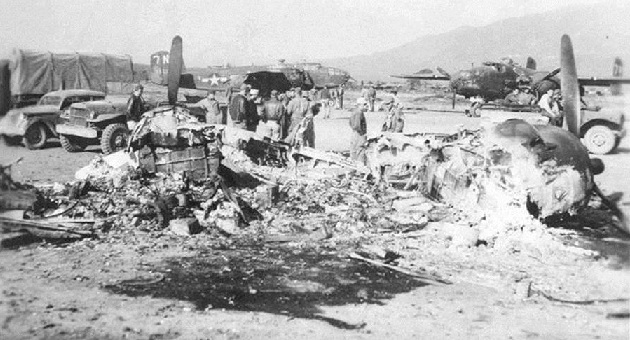
On 23 September 1944, the 340th Bombardment Group received their third Distinguished Unit Citation for their service in Italy. The group continued flying bombing missions until the end of the war in Europe.
1945
As part of Project Extraversion, two Lockheed YP-80A Shooting Star jets (44-83028 and 44-83029) arrived at Lesina Airfield (part of the Foggia Airfield Complex) in early January 1945, around the time Arado Ar 234B reconnaissance jets based at Udine, Northern Italy, began flying reconnaissance missions over Allied lines along the Italian front. The YP-80As were attached to the 94th Fighter Squadron “Hat In The Ring,” 1st Fighter Group, equipped with P-38J Lightnings (in 1946 the 94th was re-equipped with P-80s.) The jets were flown on two non-operational reconnaissance sorties and neither of them had seen combat before the end of the war. Both jets were returned to the USA.
YP-80A 44-83028 and 44-83029 fly past the silent Mount Vesuvius in early 1945.
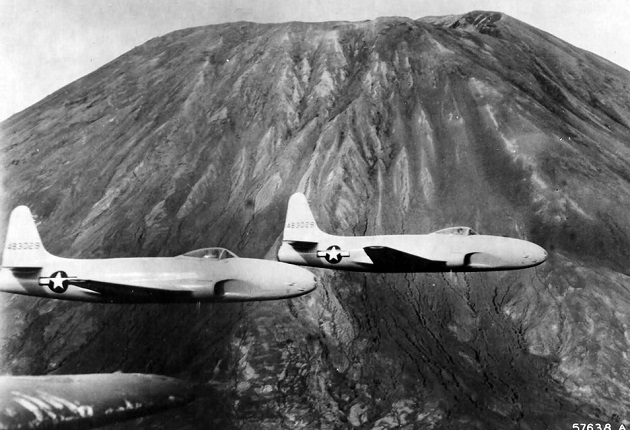
B-25J-25/27-NC s/n 44-30092 “Finito Benito Next Hirohito” was assigned to the 12th Bomb Group in early 1944. In March 1944, the Group was transferred from the 12th Air Force in Italy to the 10th Air Force in India. The name reflected the group’s change in theater assignment. Finito is an informal way to say “finished” or “done”. The name Benito referred to the Benito Mussolini and Hirohito was the emperor of Japan. At the end of the war, this B-25J was neither assigned to a bomb group nor flying combat missions but was based at Naples with the 12th Air Force. Most likely it was left behind in Italy when the 12th Bomb Group went to India in 1944.
The name “Finito Benito Next Hirohito” was painted in red across the top of the wings instead of the usual placement on the nose of the airplane. The wings and the number 12 on top of the fuselage most likely referred to the 12th Bomb Group.

B-25J “Finito Benito Next Hirohito” flying over the crater of Mount Vesuvius in May 1945. If this photo was actually taken in the early 1944, there would been some volcanic activity inside the crater.
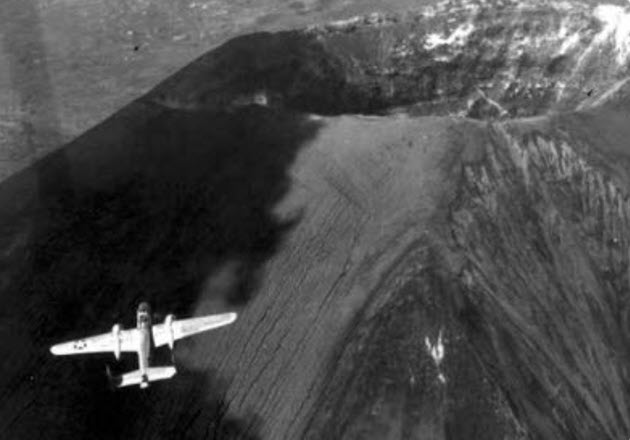
This is my close up of the B-25J in the photo above.

Post War
After the war, Capodichino Airfield became Capodichino Airport and commercial traffic started in 1950. Today it is the Naples International Airport.
Mount Vesuvius was still a hazard even when it was not erupting. On 15 February 1958, a USAF Douglas VC-47A Skytrain, 42-93817, c/n 13771, built as a C-47A-25-DK and upgraded, was en route from its home base, Ramstein-Landstuhl Air Base, Germany, to Istanbul, Turkey. It made an intermediate stop at Capodichino Airport landing at 1329 hours and later departed on a flight to Athens, with 16 servicemen (6 crew and 10 passengers) aboard. Following a report 30 minutes after departure (2224 hours) when the crew reported en route at 6500 feet (1981.2 m) and switching to Rome air traffic control, nothing further was heard from the plane, which never contacted Rome, nor arrived in Greece. Dense fog over the Ionian Sea and mountainous southern Italy on February 17 greatly impeded the search efforts for the missing aircraft.
On February 19, the burned and scattered wreckage was found high on the rugged slope of Vesuvius at the 3800 foot (1158 m) level, about 200 feet (61 m) below the top of the cone of the volcano. A search plane first spotted the wreckage following four days of a ground, sea and air search impeded by fog, rain and snow. Patrols of US servicemen, Italian soldiers and carabinieri reached the crash site four hours after it was located, battling though heavy snow, but reported no survivors amongst the 16 that were on board. All 16 had been identified and their deaths were determined to been instantaneous. The cause of the crash was speculated that the weather was bad that night and the pilot was unfamiliar with the terrain surrounding Capodichino Airport.
Next Eruption?
Its been 78 years since the last major eruption of Vesuvius. Vesuvius is still considered an active volcano and it will erupt again someday but nobody knows exactly when. Since 1944, there were hundreds of minor earthquakes reported in the region and there are more than 3 million people living in the vicinity of the volcano — the highest concentration of people living near an active volcano anywhere on earth. Maybe Vesuvius will remain quiet for a few centuries similar to what happened during the middle ages.
If you live in the Naples/Pompeii area or are just visiting and you see large amounts of smoke bellowing high into the sky from Vesuvius . . . take a couple of selfies with Vesuvius in the background . . . then get the hell out of there!
Some B-25C/D Information
The North American Aviation (NAA) B-25 medium bomber was named in honor of Brigadier General William “Billy” Lendrum Mitchell, a pioneer of US military aviation. Mitchell was the first person for whom an American military aircraft design was named after. The B-25C and B-25D differed only in the location of manufacture: B-25Cs were built in Inglewood, California, and the B-25Ds were built in Kansas City, Kansas. Originally it had a crew of five: pilot, co-pilot, navigator, bombardier, and gunner (top turret). A tail gunner was included if the “stinger” tail gun position had been installed.
B-25C/D Serial Numbers:
| Variant | Serial Number Range | Number Built |
| B-25C | 41-12434 . . . . . 41-13038 | 605 |
| B-25C-1 | 41-13039 . . . . . 41-13296 | 258 |
| B-25D | 41-29648 . . . . . 41-29847 | 200 |
| B-25D-1 | 41-29848 . . . . . 41-29947 | 100 |
| B-25D-5 | 41-29948 . . . . . 41-30172 | 225 |
| B-25D-10 | 41-30173 . . . . . 41-30352 | 180 |
| B-25D-15 | 41-30353 . . . . . 41-30532 | 180 |
| B-25D-20 | 41-30533 . . . . . 41-30847 | 315 |
| B-25C-10 | 42-32233 . . . . . 42-32382 | 150 |
| B-25C-15 | 42-32383 . . . . . 42-32532 | 150 |
| B-25C-5 | 42-53332 . . . . . 42-53493 | 162 |
| B-25C-20 | 42-64502 . . . . . 42-64701 | 200 |
| B-25C-25 | 42-64702 . . . . . 42-64801 | 100 |
| B-25D-20 | 42-87113 . . . . . 42-87137 | 25 |
| B-25D-25 | 42-87138 . . . . . 42-87452 | 315 |
| B-25D-30 | 42-87453 . . . . . 42-87612 | 160 |
| B-25D-30 | 43-3280 . . . . . . 43-3619 | 340 |
| B-25D-35 | 43-3620 . . . . . . 43-3869 | 250 |
Some 340th Group aircraft information:
| Tail Code | Variant | Serial Number | Bomber Name |
| 6B | B-25C-10 | 42-32309 | The Devil’s Helper |
| 6C | B-25D-5 | 41-29980 | The Kawani Kid II |
| 6D | B-25C-10 | 42-32316 | Cow Town Avenger |
| 6E | B-25? | 42-? | Who Cares? |
| 6K | B-25? | 42-? | I’ll take you home again Kathleen |
| 6U | B-25C-5 | 42-53464 | Lil Bea Hind |
| 7C | B-25? | ? | Rosie |
| 7D | B-25? | ? | ? |
| 7U | B-25C-15 | 42-32530 | ? |
| 8T | B-25C-20 | 42-64568 | The Grayling |
| 8U | B-25? | ? | ? |
| 8V | B-25D-5 | 41-30111 | The Falcon |
| 9C | B-25D-35 | 43-3634 | Ellen E. and Son |
| 9D | B-25C-15 | 42-32447 | Stardust |
| 9? | B-25C-1 | 41-13290 | OH! MOMMY! |
Notes:
6C “The Kawani Kid II” was transferred from the 310th Bomb Group.
9D “Stardust” had 78 missions when it was destroyed on 22 March 1944.
MODEL KITS AND 3D MODELS
1/48:
Accurate Miniatures 3431 B-25C/D Mitchell – 2005
Italeri 2650 B-25 Mitchell – 2006
Tamiya 32548 U.S. 2.5 Ton 6×6 Cargo Truck – 2007
1/72:
Airfix A06015 North American B-25C/D Mitchell – 2018
Academy 13402 U.S. 2-1/2 Ton 6×6 Cargo Truck & Accessories – 2004
3D CAD BROWSER Mount Vesuvius Model
Turbosquid Mount Vesuvius 3D Model
Instructions for Building an Erupting Model of Vesuvius
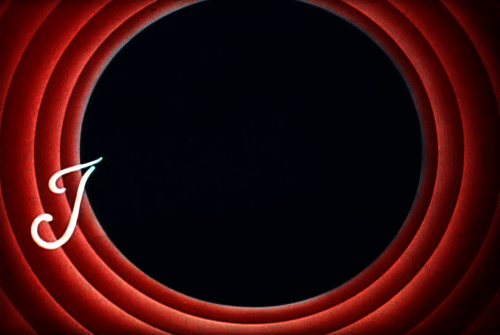
Reblogged this on Lest We Forget II and commented:
Impressive research!
LikeLike
What a marvellous and well researched piece of writing, illustrated with so many superb photographs. I was particularly impressed with the information about the YP-80A Shooting Stars. I had never realised that such aircraft came to Europe, The British jet, the Meteor, was used in NW Europe in a very small way, but they had to be painted bright white all over because there was such a risk of “friendly fire”.
LikeLike
What a great post, thank you! Have you seen this paper from David Chester and colleagues on the responses of the Anglo-American military authorities to the eruption? It was published in 2007 in the Journal of Historical Geography, and needs a login to see the whole paper – HERE
LikeLike